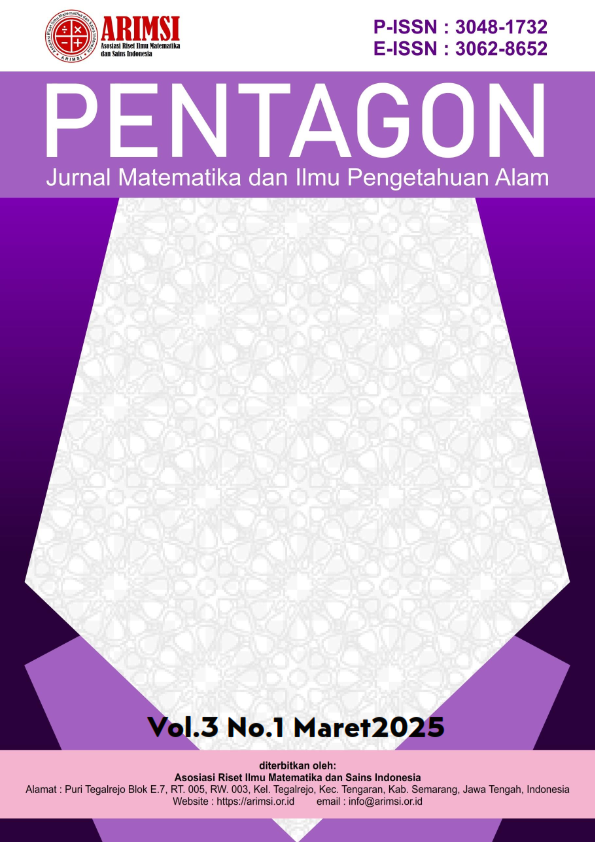The Effect of Ethnoscience Approach Through Problem Based Learning Model on Chemical Literacy Ability of Class XI Students on Reaction Rate Material at SMA Negeri 7 Gorontalo
DOI:
https://doi.org/10.62383/pentagon.v3i1.388Keywords:
Ethnoscience, PBL, Chemical Literacy, Reaction RateAbstract
The research aims to determine the effect of the ethnoscience approach through the problem-based learning model on the chemical literacy skills of Grade XI students in the reaction rate material at SMA Negeri 7 Gorontalo. The research employs a quasi experimental method with a nonequivalent control group design. The sample consisted of Grade XI IPA ( Natural Science) students from SMA Negeri 7 Gorontalo. The instrument used in this research was an essay test. Data processing and analysis were conducted using Microsoft Office Excel and SPSS version 16. The hypothesis test results on students’ post-test data using the Mann-Whitney test at a significance level of α = 0.05 showed that the Asymp. Sig. (2-tailed) value was less than 0.05 (0,002 < 0,05). Therefore, H1 was confirmed, and H0 was rejected. The N- Gain test results also indicated that the ethnoscience approach through the problem-based learning model was moderately effective in improving students’ chemical literacy skills in reaction rate material, with the experimental class achieving an N-Gain score percentage of 57.13% (moderately effective category), while the control class achieved a percentage of 31.42% (ineffective category). In conclusion, the ethnoscience approach through the problem-based learning model significantly affects students’ chemical literacy skills in reaction rate material.
Downloads
References
Aiman, U., Dantes, N., & Suma, K. (2019). Pengaruh model pembelajaran berbasis masalah terhadap literasi sains dan berpikir kritis siswa sekolah dasar. Pendidikan Citra Bakti, 6(November), 196–209. https://doi.org/10.5281/zenodo.3551978
Amin, N. F., Garancang, S., & Abunawas, K. (2023). Konsep umum populasi dan sampel dalam penelitian. Jurnal Pilar, 14(1), 15–31.
Desni, N. W., Sihaloho, M., & Pikoli, M. (2019). Studi komparasi kemampuan berpikir kritis siswa menggunakan model pembelajaran Problem Based Learning dan Discovery Learning pada materi larutan penyangga di kelas XI SMA Negeri 1 Telaga. Jambura Journal of Educational Chemistry, 1(2), 63–68. https://doi.org/10.34312/jjec.v1i2.2666
Fahmina, S. S., Indriyanti, N. Y., Setyowati, W. A. E., Masykuri, M., & Yamtinah, S. (2019). Dimension of chemical literacy and its influence in chemistry learning. Journal of Physics: Conference Series, 1233(1). https://doi.org/10.1088/1742-6596/1233/1/012026
Imansari, M., Sumarni, W., & Sudarmin. (2018). Analisis literasi kimia peserta didik melalui pembelajaran inkuiri terbimbing bermuatan etnosains. Jurnal Inovasi Pendidikan Kimia, 12(2), 2201–2211.
Iyabu, H., Ischak, N. I., & Supriadin, Y. (2021). Pengaruh model pembelajaran NHT (Numbered Heads Together) dengan bantuan multimedia interaktif terhadap hasil belajar siswa pada materi laju reaksi. Jambura Journal of Educational Chemistry, 3(2), 53–60. https://doi.org/10.34312/jjec.v3i2.11897
Khoiri, A., & Sunarno, W. (2018). Pendekatan etnosains dalam tinjauan fisafat. SPEKTRA: Jurnal Kajian Pendidikan Sains, 4(2), 145. https://doi.org/10.32699/spektra.v4i2.55
Kosanke, R. M. (2019). BAB III rancangan penelitian, desain penelitian, variabel penelitian, populasi dan sampel, serta teknik pengumpulan data. Jurnal Artikel, 22–38.
Mellyzar, M., Lukman, I. R., & Busyraturrahmi, B. (2022). Pengaruh strategi Process Oriented Guided Inquiry Learning (POGIL) terhadap kemampuan proses sains dan literasi kimia. Jambura Journal of Educational Chemistry, 4(2), 70–76. https://doi.org/10.34312/jjec.v4i2.15338
Muntholib, Ibnu, S., Rahayu, S., Fajaroh, F., Kusairi, S., & Kuswandi, B. (2020). Chemical literacy: Performance of first-year chemistry students on chemical kinetics. Indonesian Journal of Chemistry, 20(2), 468–482. https://doi.org/10.22146/ijc.43651
Nurhaedah, N., Hartoto, H., & Amalia, N. I. (2022). The effect of Problem Based Learning model on students’ outcomes in learning natural science of 5th grade at UPT SDN 104 Tontonan Anggeraja District Enrekang Regency. International Journal of Elementary School Teacher, 2(1), 39. https://doi.org/10.26858/ijest.v2i1.34005
Putri, A., Sudarisman, S., & Ramli, M. (2014). Pengaruh model Problem Based Learning berbasis potensi lokal pada pembelajaran biologi terhadap kemampuan literasi sains siswa kelas X SMA Negeri 1 Cepogo. Bio-Pedagogi, 3(2), 81. https://doi.org/10.20961/bio-pedagogi.v3i2.5344
Sandabunga’, S., Anwar, M., & Alimin, A. (2021). Pengaruh model Problem Based Learning terhadap hasil belajar peserta didik kelas XI MIA SMAN 2 Makassar (Studi pada materi pokok laju reaksi). Chemica: Jurnal Ilmiah Kimia dan Pendidikan Kimia, 22(2), 91. https://doi.org/10.35580/chemica.v22i2.26213
Sanova, A., Afrida, A., Bakar, A., & Yuniarccih, H. (2021). Pendekatan etnosains melalui model Problem Based Learning terhadap kemampuan literasi kimia materi larutan penyangga. Jurnal Zarah, 9(2), 105–110. https://doi.org/10.31629/zarah.v9i2.3814
Sopandi, W. (2020). Materi dan sifatnya, serta kegunaan bahan kimia dalam kehidupan. Peki4401/Modul 3, 1–45. https://pustaka.ut.ac.id/lib/peki4401-materi-kurikuler-kimia-smp-dan-sma/
Temuningsih, P., Peniati, E., & Marianti, A. (2017). Pengaruh penerapan model Problem Based Learning berpendekatan etnosains pada materi sistem reproduksi terhadap kemampuan berpikir kritis siswa. Journal of Biology Education, 6(1), 70–79. https://doi.org/10.15294/jbe.v6i1.14060
Uliyandari, M., Candrawati, E., Herawati, A. A., & Latipah, N. (2021). Problem-Based Learning to improve concept understanding and critical thinking ability of science education undergraduate students. IJORER: International Journal of Recent Educational Research, 2(1), 65–72. https://doi.org/10.46245/ijorer.v2i1.56
Umar, I., M., R., & Sato. (2022). Prestasi belajar akuntansi keuangan melalui model pembelajaran Problem Based Learning pada siswa kelas XI Akuntansi SMK Negeri 1 Wanggarasi Kab. Pohuwato Gorontalo. Jurnal Pemikiran dan Pengembangan Pembelajaran, 4(1), 125–134.
Downloads
Published
How to Cite
Issue
Section
License
Copyright (c) 2025 Pentagon : Jurnal Matematika dan Ilmu Pengetahuan Alam

This work is licensed under a Creative Commons Attribution-ShareAlike 4.0 International License.





